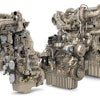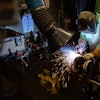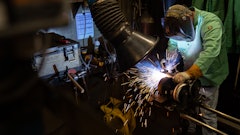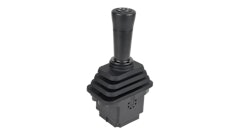Anyone who has looked at the new generation of wheel loaders for the construction market has probably taken note of the futuristic designs. No more “square edges”, these loaders feature short, rounded rear ends with high-visibility cabs. But this is more than a design exercise — these wheel loaders offer many productivity boosting advantages.
It’s about more than glass
Some manufacturers boast about the surface area of glass used in their cabs, but this is not necessarily a good measure of the wheel loader’s visibility. “Really it’s the obstructions on the machine that ultimately limit your visibility,” says Dan Snedecor, wheel loader business line, Volvo Construction Equipment. “There are companies that put in a lot of glass that goes all the way down to the floor, and basically all you see is the back of your front frame or the back of your fenders. You really don’t see anything we deem as practical.”
This can actually have a negative influence on the operator environment. “Glass is a very poor insulator of noise and vibration,” says Snedecor. “We really pride ourselves on operator comfort, keeping the internal cab noise to a minimum. So we have stuck to our guns as far as limiting glass to real visibility and not just doing it for the aesthetic effect.”
In addition, the shape of the glass can affect visibility. “Case has maintained basically flat glass throughout its cab,” says Dave Wolf, marketing manager, Case Construction Equipment. “It is easier to replace and you eliminate any kind of distortion that you would have with curved glass.”
Snedecor adds that visibility to attachments is also critical on utility-sized wheel loaders. “You should put the attachment all the way to the ground. From a normal seated position, identify how much of the attachment you can see,” he advises. “You want to be able to see those things function at ground level because that is where you are picking up objects. You shouldn’t have to stand up or lean forward or adjust your position in any way.”
Designs improve sight lines
Many manufacturers have addressed obstacles that do impair important sight lines. For instance, rear hoods have been sloped to increase rear visibility.
This was no small task. “What Case has done on the D Series wheel loader, we have a mid-mounted cooling module,” says Wolf. “That means that all of our coolers are in a box located directly behind the cab.” That enabled the placement of the engine behind the rear axle and lower. “So we gained excellent visibility to the rear of the machine.”
John Deere also concentrated on rear visibility with its latest design. “Our Quad-Cool design provides for a narrow and tapered rear to the machine for better visibility to the back tires and to the back,” notes O’Keefe, “especially in tight quarters for maneuverability and in case someone was approaching from the side or rear.”
“Our frame posts have been made smaller and moved out of the operator’s line of sight forward,” says Komatsu America ’s Post. “Front windshield panels are joined together using clear silicon adhesive rather than rubber sashes or steel bars.”
Similarly, many manufacturers have redesigned the loader linkages and re-routed hydraulic lines to improve visibility to the work tool. “We have re-routed our hydraulic lines,” says Case’s Wolf. “Instead of a high, looping hydraulic line, it is now tucked and runs directly alongside the lift arms. So it is a very low-profile routing of the lines.”
Komatsu relocated the cylinders on its tool carriers for increased visibility. “Hydraulic cylinders have been moved from atop in-line loader arms on tool carriers to give better visibility to bucket corners,” says Post. “Hoses to the cylinders are routed under the cylinders for better visibility to the attachment.”
Visibility was also a major component in the design of John Deere’s Powerllel linkage. “We designed the linkage arms low and attached cylinders and hoses to sides or on the bottom of the loader arms,” says O’Keefe. “We maximized the windows in our coupler design to see through to forks at various linkage heights. Using virtually reality, we were able to maximize visibility to the working tool prior to building parts.”
Attachments for specific carriers
Some of the attachments have actually been optimized to provide maximum visibility with specific makes of wheel loaders.
For example, Case Corp. has worked with its attachment supplier and changed the way its forks were designed. “We used to have a bar that went all the way across, which was right in the sight line to the tips of the forks,” says Wolf. This bar has been relocated to increase visibility to the end of the forks.
Similarly, Volvo has developed specific forks optimized for its wheel loaders. “The windows in our bracket line up with the windows that are in our attachment,” says Snedecor. The result is unobstructed visibility for the length of the forks.
One size fits all
Utility-size wheel loaders are common in many fleets. “In this size range, you typically have multiple operators on the machine,” says Snedecor.
You must be able to accommodate operators of varying shapes and sizes. This is where adjustable controls and seats becomes important to productivity. “Being able to mold that cab around the operator is probably going to be the most important feature for operator comfort,” says Wolf.
Tilt steering, adjustable armrests and air suspension seats are becoming common options for most manufacturers. “Air seats are becoming more and more popular,” says Snedecor. “It is more expensive by 30% to 40%, but it does a better job of keeping the operator comfortable and reducing back strain.” This is due to the fact that operators are less likely to adjust the spring tension on mechanical seats, especially if they are only going to be in the loader for half a day. “So the simplicity of adjustment [with the air seat] is going to improve the operator’s comfort. He is more likely to adjust it.”
Volvo also offers an adjustable hydraulics console. “You can raise it or lower it,” says Snedecor. “You can slide it front to back. One of the problems with having a fixed control tower is the guy could move the seat back and forth to the steering wheel relative to the pedals, but the hydraulic controls were always in one spot.” This would not accommodate different arm lengths.
Reduce operator work input
Pilot controls and automated features such as return to dig and return to carry reduce the motions required by the operator during the day. Pilot controls are more precise and take less effort,” says Post.
In addition, improvements in transmissions result in less input from the operators. “Automatic transmissions provide less shifting,” notes Post.
John Deere provides the operator a choice of operating the transmission in either auto or manual modes. “It allows the operator to focus on operation as opposed to shifting,” says O’Keefe.
Most manufacturers have also incorporated a FNR switch into
loader controls. This allows operators to change direction without having to take their hands off of the steering wheel.
Volvo just recently introduced an automatic kickdown feature on all but the very smallest machines. “The operator no longer has to select a kickdown to first gear,” says Snedecor. When the wheel loader enters a pile, the transmission will sense that and kick the machine down automatically.
Isolation from the environment
Keeping the operator protected from shock loads, vibration and the environment makes for a more pleasant work environment and increases productivity.
Ride control has long been praised for the benefits of reduced material spillage and being able to transport materials at increased speeds. But there is also a major benefit in terms of operator comfort, and now this technology is finding its way onto the smaller utility loaders. “It reduces shock loads on the operators and machines,” says Wolf.
“Ride control is optimized to each loader, which eliminates shaking, bouncing and fatigue to the operator,” adds O’Keefe.
Manufacturers have also worked hard to eliminate vibration, with many rubber mounting the cabs. “Our cabs are mounted on viscous dampers, which act like shock absorbers for the cab,” says Komatsu America ’s Post. “Drivetrain components are mounted on rubber donuts to isolate vibration.”
Volvo has even redesigned the engine mounts. “We went from a four-point mounting to a three-point mounting,” says Snedecor. “Because the engine isn’t so rigidly mounted in the frame, those vibrations are not transmitted directly into the frame.” The movement in the engine is not really perceptible, but it makes a big difference in terms of vibration. There is much less vibration travelling through the frame to the cab.
Pressurized cabs keep dirt out of the operator environment. “Cabs are fully sealed and pressurized by the air conditioning system,” says Post.
Cab filtration systems also prevent dust ingression. “We have improved cab filtration both for external air and recirculated air,” says Case’s Wolf.
“We use a two-stage cab air filter that filters to 0.4 microns,” says Snedecor. “If the operator opens the door to talk to someone and a bunch of dust flies in, that air will actually be cleaned as it recirculates. So the air is basically cleaner once the machine has been running for a while than it is when you get in.”
Air conditioners are also becoming more sophisticated. “Air conditioning is evolving to climate control systems so that an operator can get his own constant temperature and it can be maintained,” says Wolf.
This article originally appeared in the March 2005 issue of sister publication Equipment Today.















